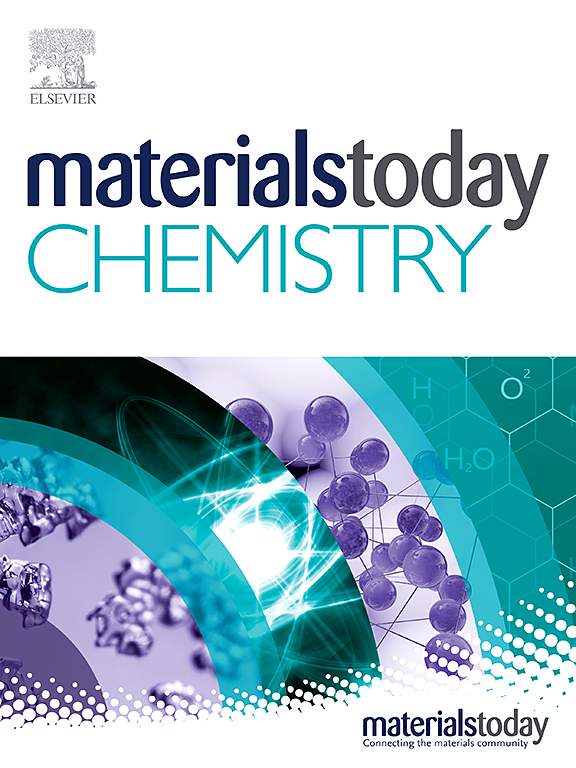Disentangling the efficient photocatalytic reduction of CO2 by a stable UiO-66-NH2/Cs2AgBiBr6 catalyst
IF 6.7
2区 化学
Q1 CHEMISTRY, MULTIDISCIPLINARY
引用次数: 0
Abstract
The compelling global warming crisis as well as extraterrestrial artificial light synthesis craves photocatalytic reduction of CO into fuels and value-added chemicals, for which efficient and robust catalysts with high selectivity and conversion rate is a prerequisite but hitherto a rarity. Herein we create a lead-free double metal perovskite of CsAgBiBr, coupling with mesoporous/microporous UiO-66-NH MOF to form type-II heterojunctions for efficient photocatalytic reduction of CO with a high CO selectivity of 95 % at an electron consumption rate of 33 μmol g h (13.4 μmol g h for CO and 0.72 μmol g h for CH). Multilayered mesoporous MOF particles manifest higher catalytic activity than their microporous counterparts due to the highly open mesoporous channels and larger pore volume of the former. Femtosecond transient absorption in combination with in situ infrared spectroscopic measurements disentangle the underlying mechanism accounting for the high product selectivity: the ultrafast electron transfer of 12.3 ps from CsAgBiBr to UiO-66-NH-2 enables efficient charge separation; primary *COOH intermediates and rapid CO desorption from Bi-based photocatalyst lead to dominant CO product. Moreover, the MOF crystals maintain stability after γ-rays irradiation equivalent of over 45-year accumulation in a typical earth orbit, hinting their promising potential in extraterrestrial artificial light synthesis.解析稳定的 UiO-66-NH2/Cs2AgBiBr6 催化剂对二氧化碳的高效光催化还原作用
迫在眉睫的全球变暖危机和地外人工光合成需要光催化还原一氧化碳为燃料和高附加值化学品,而具有高选择性和高转化率的高效、坚固催化剂是前提条件,但迄今为止却非常罕见。在此,我们创造了一种无铅双金属包晶 CsAgBiBr,与介孔/微孔 UiO-66-NH MOF 相结合,形成 II 型异质结,用于高效光催化还原 CO,CO 选择性高达 95%,电子消耗率为 33 μmol g h(CO 为 13.4 μmol g h,CH 为 0.72 μmol g h)。多层介孔 MOF 颗粒的催化活性高于微孔颗粒,这是因为前者具有高度开放的介孔通道和较大的孔体积。飞秒瞬态吸收结合原位红外光谱测量揭示了高产物选择性的内在机理:CsAgBiBr 与 UiO-66-NH-2 之间 12.3 ps 的超快电子转移实现了高效的电荷分离;初级 *COOH 中间产物和 Bi 基光催化剂的快速 CO 解吸导致 CO 产物占主导地位。此外,MOF 晶体在γ 射线辐照后仍能保持稳定,相当于在典型地球轨道上积累了 45 年以上,这表明它们在地外人造光合成方面具有广阔的潜力。
本文章由计算机程序翻译,如有差异,请以英文原文为准。
求助全文
约1分钟内获得全文
求助全文
来源期刊

Materials Today Chemistry
Multiple-
CiteScore
8.90
自引率
6.80%
发文量
596
审稿时长
33 days
期刊介绍:
Materials Today Chemistry is a multi-disciplinary journal dedicated to all facets of materials chemistry.
This field represents one of the fastest-growing areas of science, involving the application of chemistry-based techniques to the study of materials. It encompasses materials synthesis and behavior, as well as the intricate relationships between material structure and properties at the atomic and molecular scale. Materials Today Chemistry serves as a high-impact platform for discussing research that propels the field forward through groundbreaking discoveries and innovative techniques.
 求助内容:
求助内容: 应助结果提醒方式:
应助结果提醒方式:


